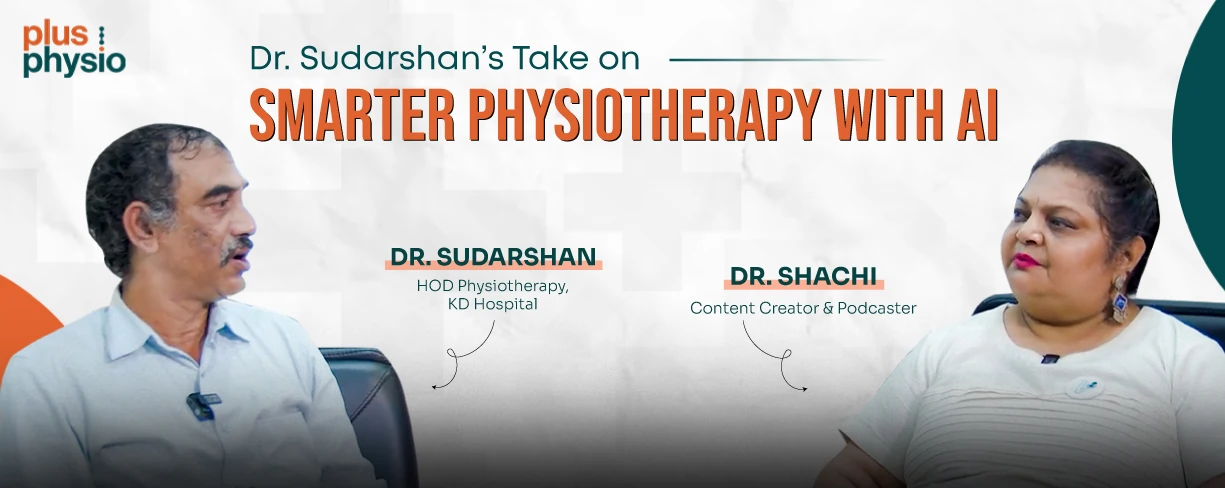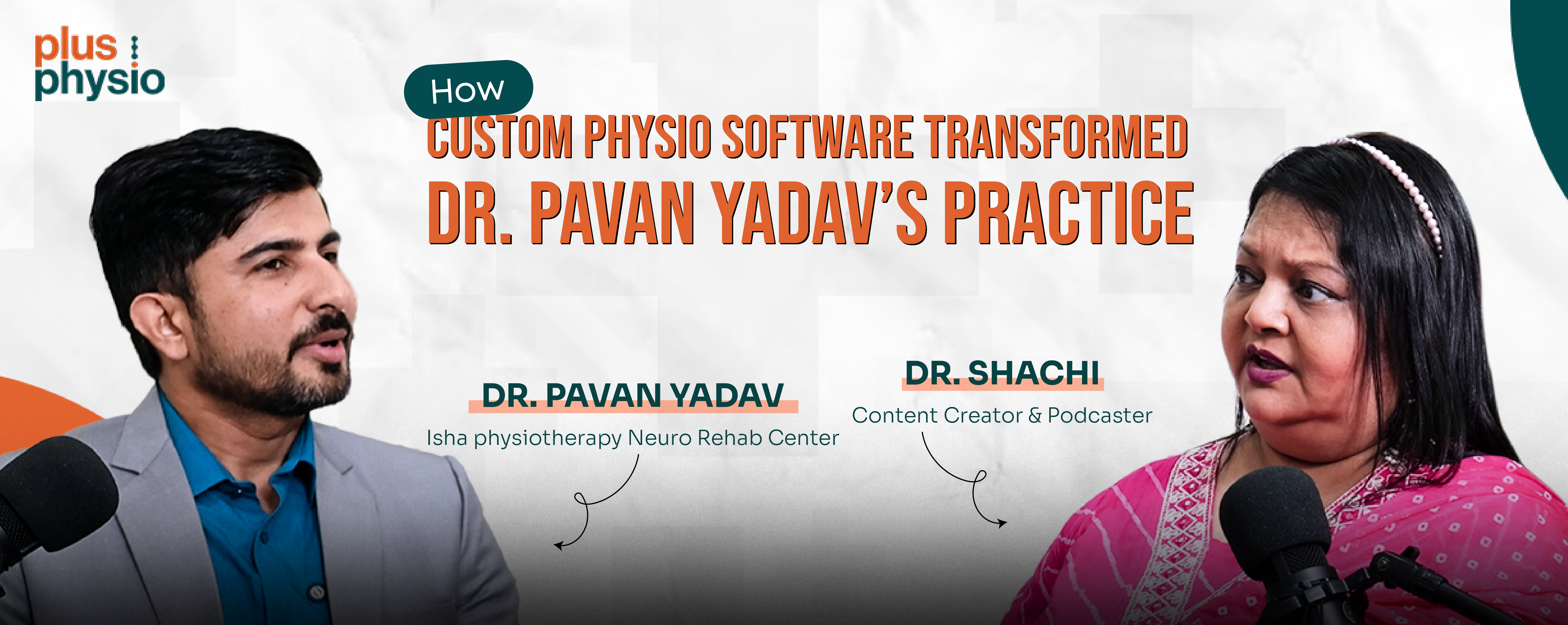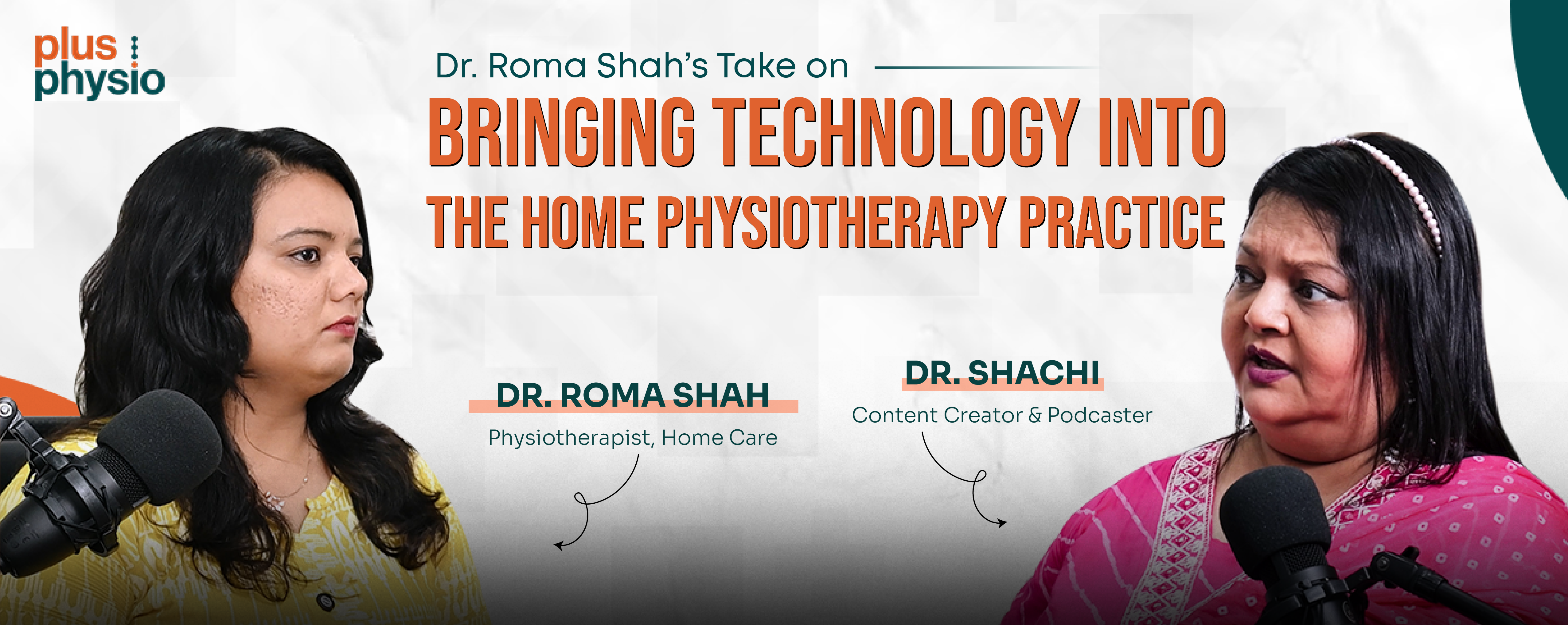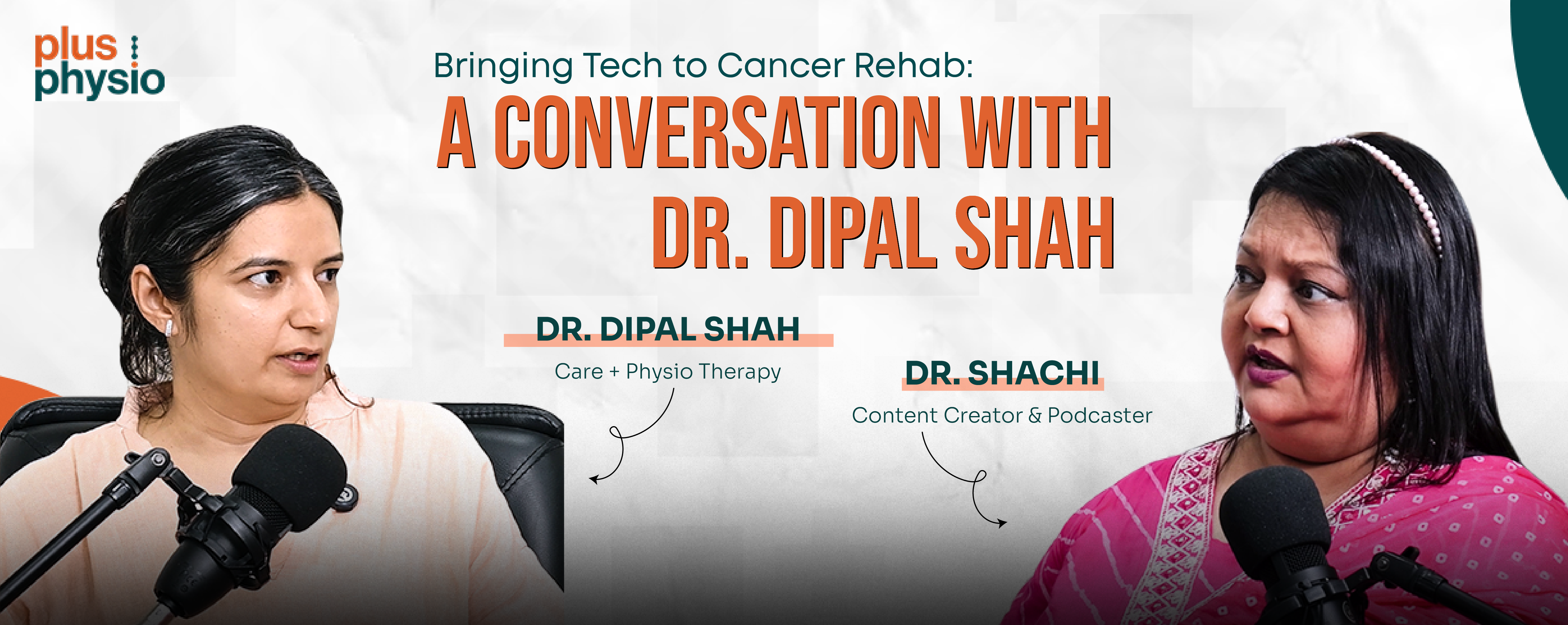Physiotherapy has come a long way - from handwritten notes to advanced digital tools and now AI-driven solutions. To understand this journey, PlusPhysio spoke with Dr. Sudarshan, Head of Physiotherapy at KD Hospital, who shared his decades of experience, the challenges physiotherapists face, and how technology is transforming the field.
DS
Dr. Shachi
“As the Head of Physiotherapy, you and your team must face challenges with new patients as well as returning ones. What are the main difficulties?”
DS
Dr. Sudarshan
“In the early years of my career, we didn't even maintain written records. A patient would walk in, I'd treat them, and that was it. If the same patient returned after years, we had to rely on memory—or hope the patient remembered. Documentation wasn't a priority, though it was taught during training. But once we moved into practice, it simply faded away.”
Times, however, have changed. With the rise of insurance requirements and professional systems, maintaining records has become essential.
“Today, everything is digitized. Assessments, treatments, and outcomes are uploaded instantly. Without proper documentation, you can't track patient progress or measure results. Digitalization has reduced challenges and made record-keeping a natural part of practice,” he explained.
DS
Dr. Shachi
“Before adopting software, did you ever use pen and paper? And how do you compare that with digital systems now?”
DS
Dr. Sudarshan
“Initially, no. Even pen and paper were rare in my practice. But as the field evolved, digital records became the norm. They not only help us remember what was done but also allow us to show outcomes to the next generation of physiotherapists. For example, I carried out early mobilization on a ventilated patient 25 years ago, but I never documented it. If I had, it would have served as valuable evidence for others.”
Digital records, he added, are no longer optional—they are tools that shape better treatment plans and improve recovery tracking.
Time management is one of the biggest challenges in physiotherapy. Double bookings, missed appointments, and unclear records used to cause confusion.
“In my early days, I sometimes ended up giving two patients the same appointment slot. That's where software—especially AI-driven scheduling—plays a crucial role. It minimizes errors and makes practice more efficient,” Dr. Sudarshan said.
But AI doesn't stop at scheduling. It can record patient interactions, generate treatment summaries, and even suggest personalized exercise regimes based on a patient's height, weight, and condition.
“Predictive models can motivate patients by showing them possible outcomes if they follow or skip a treatment plan. And imagine AI-powered machines assisting patients directly with exercises based on physiotherapists' instructions—that's the future we're stepping into,” he added enthusiastically.
Dr. Sudarshan recalled how, years ago, gait analysis was a “jugaad” experiment with multiple cameras placed around a patient. Today, AI-powered systems perform the same analysis in seconds, with far greater accuracy.
At KD Hospital, a new AI-driven physiotherapy department is being set up. Machines will connect to an app, track repetitions and workloads, and securely store patient progress.
“The app ensures that both the patient and physiotherapist can access records anytime. With rising patient volumes, such tools are no longer luxuries—they're necessities,” he said.
DS
Dr. Shachi
“Do you think AI can replace physiotherapists someday?”
DS
Dr. Sudarshan
“No, never. AI will assist us, but it cannot replace the human touch. Physiotherapy is more than just exercises—it's about patient confidence, motivation, and empathy. Machines can support, but they cannot replicate that. Just like electricity didn't replace fire, AI won't replace physiotherapists. It will only make life easier.”
When asked about patient discharge summaries, Dr. Sudarshan pointed out another gap.
“Most discharge notes just say: 'Continue physiotherapy.' But they don't specify details like frequency, range of motion, or progression. That's a major shortcoming. Proper documentation can bridge this gap and guide patients better,” he emphasized.
This is exactly where solutions like PlusPhysio step in—covering pain points like documentation, treatment tracking, and patient communication.
As the conversation came to a close, Dr. Sudarshan expressed optimism:
“Physios should adopt AI and digitalization, because they are game changers. They're helping physiotherapists handle larger patient volumes, track progress, and deliver better outcomes. At the end of the day, what matters most is building a pain-free society - and technology is helping us get there faster.”
Takeaway: Digital tools and AI are not replacing physiotherapists - they're empowering them. With proper documentation, predictive models, and smart scheduling, physiotherapists can focus on what matters most: delivering effective, personalized care.
Here is the conversation between Dr. Shachi and Dr. Sudarshan, the Head of Physiotherapy at KD Hospital.
DS
Dr. Shachi
"We have been on this journey with iFour Technolab and Plus Physio. We wanted to understand the pain points of physiotherapists. We have with us today the Head of Physiotherapy at KD Hospital, Dr. Sudarshan. Welcome, Dr. Sudarshan. As the head of the department, you and your team must be facing challenges—whether with new patients or returning ones. Could you share what challenges you generally face?”
DS
Dr. Sudarshan
"Recently, with new documentation systems and IT profiling, the challenges are definitely fewer. I've been Head of Department at KD Hospital for the past few years, but before that, I headed physiotherapy departments at three to four other hospitals during my career."
DS
Dr. Shachi
"How long has your career been, sir?"
DS
Dr. Sudarshan
"About 30 years."
DS
Dr. Shachi
"So, you've been using software for 30 years?"
DS
Dr. Sudarshan
"Software? Not at all. In the initial stages of my practice, I didn't even use pen and paper. A patient would walk in, I'd treat him, and he'd pay—that was it. That's how practice was in those days. As for records, there were none. If a patient came back after four years, you'd just try to remember, or hope the patient remembered. During our physiotherapy training, they taught us how to assess and maintain records, but after internship, that stopped. Once you entered practice, documentation went out the window."
DS
Dr. Shachi
"But that wouldn't work in today's age, especially with insurance companies."
DS
Dr. Sudarshan
"No, it won't work—and it shouldn't. The practice has evolved from a family-based setup to a professionally managed industry. Today, everything is digitized. Assessments, treatments—all are uploaded online instantly. Earlier, interaction between consultants and physiotherapists was better because the workload was less. Now, the number of physiotherapists has grown, brain drain is high, and those who remain are overworked. I've never seen a physiotherapist who is free."
DS
Dr. Shachi
"So, the challenges you and your team faced were mainly around record-keeping, which came in largely due to insurance requirements?"
DS
Dr. Sudarshan
"Exactly. Initially, it was a big challenge because we weren't used to it. There was friction, and I too faced hiccups. But the medical field has moved on—it's more structured, volumes have gone up, and the depth of practice has increased."
DS
Dr. Shachi
"My next question relates to that. From the patient's arrival to discharge, there must be hiccups along the way. Are these issues large in number, or do they happen more frequently?"
DS
Dr. Sudarshan
"It really varies. Earlier, we never explained end-points to patients. Now, everything has to be documented—outcome measures, treatment plans, records. Without documentation, you can't track progress. If a patient returns after four years, how would you know what you advised or whether they followed it? Documentation is essential."
DS
Dr. Shachi
"Before digitalization, did you ever use pen and paper? And now, with software, do you see a difference?"
DS
Dr. Shachi (sharing a personal anecdote):
"I used pen and paper for a few years, but when I started my practice in 2002, I switched to software right away. Back then, there was only one software available in India, and I used it. Even today, if I meet a patient after 20+ years, I can pull up their file and know exactly what treatment I gave. The patient appreciates it, even though it's the software that remembers, not me. That's the power of records. So, I completely understand what you're saying. My question is: when you plan treatments for your patients, whether short or long-term, do you feel the absence of records affects recovery? And now that you have digitalization, are you seeing an improvement in patient outcomes?"
DS
Dr. Sudarshan
"Absolutely. Without records, only I knew what was done and what the outcome was. But if records had been maintained, I could have shown results to the next generation. For example, I performed early mobilization on a ventilated patient 25 years ago, but there's no proof of it. If documented, it would have helped others. My own mother walked within 24 hours of spinal surgery, but in those days, patients were kept in bed for weeks. People were mobilizing patients even then, but it wasn't documented. Documentation captures knowledge, ensures continuity, and reduces reliance on memory. Digitalization enforces documentation and makes it easier."
DS
Dr. Shachi
"True. It also helps with scheduling, right? In the past, if two patients were booked at the same time, how did you manage appointments?"
DS
Dr. Sudarshan
"In my early days, I would be at the clinic half an hour early, so double bookings weren't a big issue. But as my practice grew, yes, I did goof up at times with overlapping appointments. That's where software—especially AI-driven scheduling—helps a lot. It prevents such clashes."
DS
Dr. Shachi
"Exactly. Time management is critical for physiotherapists. Imagine AI recording your conversation with a patient, generating a quick summary, and sending it to both you and the patient. Wouldn't that be a wonderful tool?"
DS
Dr. Sudarshan
"That would have been fantastic if it came 30 years ago! AI could also suggest personalized physiotherapy regimes based on patient height, weight, and condition. Even predictive models that show possible outcomes would motivate patients. And if AI-powered machines could assist patients directly in exercises, based on the physiotherapist's plan—that would be revolutionary. I would grab such a tool with both hands!"
DS
Dr. Shachi
"Such software already exists—not just assistive, but predictive too. Many physiotherapists aren't even aware of them."
DS
Dr. Sudarshan
"Even I wasn't aware. Years ago, when we wanted to analyze gait, my colleagues and I used cameras from different angles. That was our ‘jugaad' gait lab. Today, AI does this with force plates in seconds! At KD Hospital, we're setting up a state-of-the-art physiotherapy department with AI-driven machines. These machines connect with an app, track repetitions, workloads, and goals, and maintain patient records securely. With rising patient inflow, gizmos like these are essential. AI is making life easier for both doctors and patients, especially with predictive modeling."
DS
Dr. Shachi
"So, do you think every hospital should adopt AI-driven physiotherapy systems?"
DS
Dr. Sudarshan
"Definitely. AI won't replace physiotherapists—just like electricity didn't replace fire—but it makes life much easier. Physiotherapy is only one part of a complex medical process involving doctors, nurses, and others. AI can streamline workflows, improve efficiency, and support better outcomes. Machines can support, but not replace, physiotherapists. At the end of the day, patient confidence and human touch matter. AI is an assistant, not a replacement."
DS
Dr. Shachi
"That's true. Before we close, let me ask—when patients are discharged, what is usually written in their summaries? And do you see pain points there?"
DS
Dr. Sudarshan
"Most discharge summaries simply say: ‘Continue physiotherapy.' But they don't specify how many times, what range of motion, or progression of exercises. This gap needs to be filled with clear documentation and digital records."
DS
Dr. Shachi
"That's exactly what PlusPhysio offers—it covers almost everything you just mentioned. It's built to handle these pain points. Thank you, Dr. Sudarshan, for such an interactive and insightful session. As the HOD of Physiotherapy at KD Hospital, your perspective is invaluable, and we're grateful for your time."
DS
Dr. Sudarshan
"I should be the one thanking you. This initiative will benefit not just physiotherapists but the entire medical community. At the end of the day, we all want better patient outcomes and a pain-free society. If AI and software can help achieve that, nothing like it."





